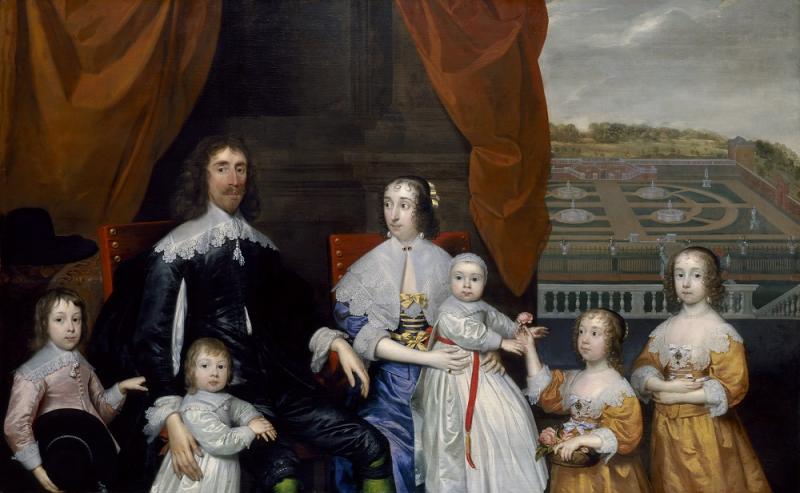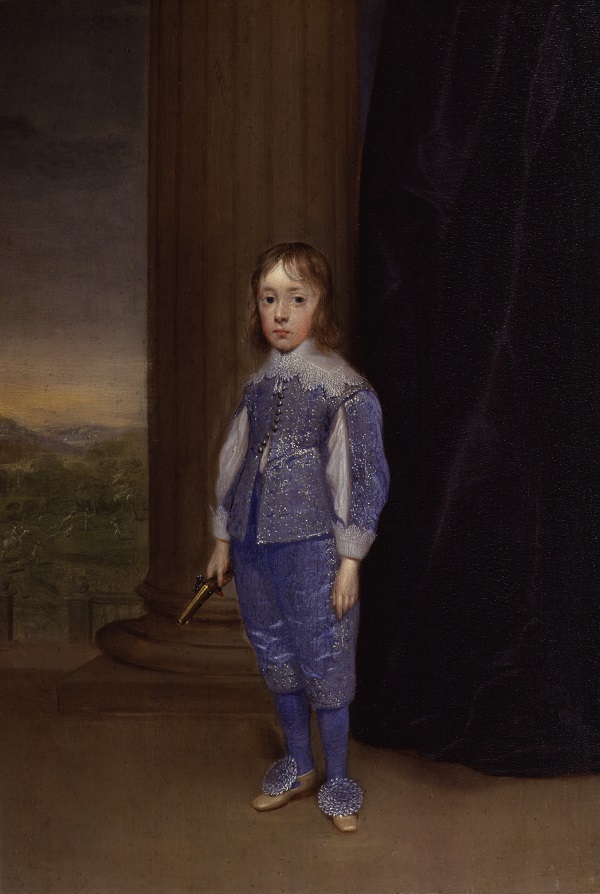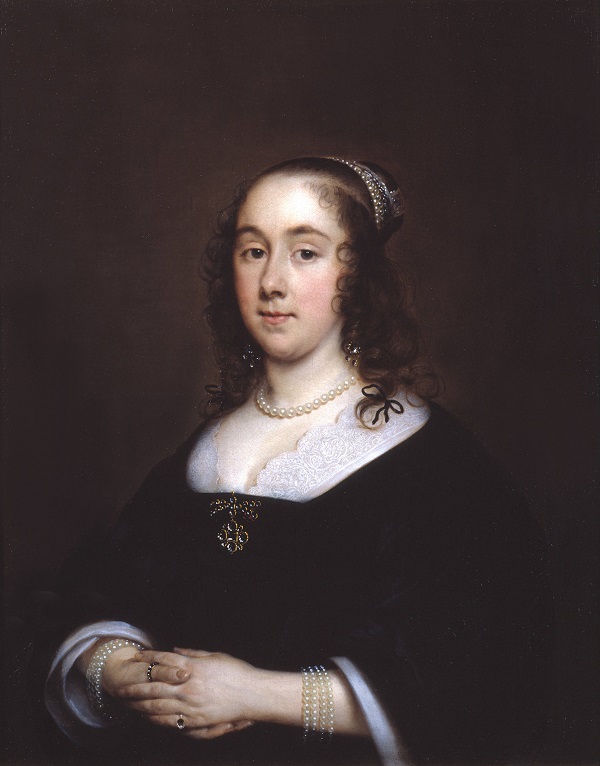Cornelius Johnson, National Portrait Gallery | reviews, news & interviews
Cornelius Johnson, National Portrait Gallery
Cornelius Johnson, National Portrait Gallery
A forgotten artist eclipsed by Van Dyck as portrait painter to Charles I

It’s far too easy to think about the history of art as a series of class acts, with one superlative achievement following another. Exhibitions tend to encourage this view, and the notion of a superstar artist is key to persuading us that the latest blockbuster is unmissable.
There can be few more minor figures than Cornelius Johnson (1593-1661), whose reputation has been eclipsed entirely by that consummate celebrity, Sir Anthony Van Dyck (1599-1641). Born in London to Flemish-German parents, Johnson may have been trained in the Netherlands, but there were so many Netherlandish immigrants in London in the early 17th century that he might well have learned such practices as adding a signature to his work, and painting on wood, as an apprentice to a Dutch painter in London.
Today, Johnson’s name is probably best known amongst the descendents of the gentry, merchants and lawyers who commissioned portraits from him, which sometimes still hang, now obscure and anonymous, on the walls of England’s faded country houses.
Johnson’s popularity amongst the English elite eventually brought him to the attention of Charles I, but the timing could not have been worse; in the same year, Van Dyck was appointed as the king’s principal painter, and like all other painters at the English court, Johnson was immediately overshadowed by Van Dyck’s extraordinary talent.
 While Van Dyck certainly got the plum jobs, some examples of Johnson’s royal commissions survive, and his small-scale portraits of the three eldest royal children demonstrate the nature of his talent. Typical of portraiture in the period before Van Dyck, and especially in depictions of royalty, these stiff little adults convey very little of the children underneath; the portraits are not about individual personalities, but represent instead the perpetuation of the royal line. They are, nevertheless, exquisite, their small size emphasising Johnson’s virtuoso treatment of the children’s fine clothes, with each piece of lace, each intricately turned rosette sparkling jewel-like in paint. (Pictured right: King James II, 1639)
While Van Dyck certainly got the plum jobs, some examples of Johnson’s royal commissions survive, and his small-scale portraits of the three eldest royal children demonstrate the nature of his talent. Typical of portraiture in the period before Van Dyck, and especially in depictions of royalty, these stiff little adults convey very little of the children underneath; the portraits are not about individual personalities, but represent instead the perpetuation of the royal line. They are, nevertheless, exquisite, their small size emphasising Johnson’s virtuoso treatment of the children’s fine clothes, with each piece of lace, each intricately turned rosette sparkling jewel-like in paint. (Pictured right: King James II, 1639)
As it is represented here, there is some variation in the quality of Johnson’s work, but it is fair to say that he was capable of rendering both flesh and fabric in beautiful, tactile detail, his brushstrokes invisible and the paint forming a perfectly smooth surface. But there is no question as to why Van Dyck was top dog. Drawing on his years spent in Italy as a highly successful painter of portraits, Van Dyck’s subjects ooze elegance, his rapid brushstrokes injecting them with life and that uncanny sense that at any moment they might move. Johnson’s figures have an earthy solidity that has an appeal of its own, but is nevertheless decidedly unglamorous.
Johnson’s portrait of The Capel Family, c.1640 (main picture), is probably his best-known work and while its composition is based on Van Dyck’s portrait of Charles I and his family, The Greate Peece, 1632, in the Royal Collection, the similarities go no further, Johnson’s gentle, but frank naturalism contrasting with Van Dyck’s highly idealised treatment.
Tempting as it is to imagine Johnson looking needily over Van Dyck’s shoulder, it seems that the exchange of ideas was fairly evenly weighted, with Van Dyck borrowing compositional ideas from his lesser-known colleague.
 Even so, after years of being overlooked by the king, Johnson could have been forgiven if he had developed a slight spring in his step when Van Dyck died in 1641. But when Civil War broke out in 1642, it extinguished any remaining hope he might have had for his prospects in the English court.
Even so, after years of being overlooked by the king, Johnson could have been forgiven if he had developed a slight spring in his step when Van Dyck died in 1641. But when Civil War broke out in 1642, it extinguished any remaining hope he might have had for his prospects in the English court.
Johnson must have been a resilient, pragmatic sort of character, however, because shortly afterwards he emigrated with his family to the Netherlands, prospering as a portrait painter to the Dutch bourgeoisie. Some of his most accomplished portraits come from this period, and Johnson’s understated, modest style must have struck a chord with the fashionable Dutch elite, who liked to ostentatiously tone down their finery by wearing sober, if expensive clothes (Pictured above left: Portrait of an Unknown Lady, 1646).
In the fullness of time, a bigger exhibition might allow direct comparisons between Johnson’s work and those of contemporaries like Van Dyck. But for now, this tiny exhibition provides a tantalising dip into art history’s footnotes, and a welcome diversion from the headline acts.
Explore topics
Share this article
Add comment
The future of Arts Journalism
You can stop theartsdesk.com closing!
We urgently need financing to survive. Our fundraising drive has thus far raised £49,000 but we need to reach £100,000 or we will be forced to close. Please contribute here: https://gofund.me/c3f6033d
And if you can forward this information to anyone who might assist, we’d be grateful.

Subscribe to theartsdesk.com
Thank you for continuing to read our work on theartsdesk.com. For unlimited access to every article in its entirety, including our archive of more than 15,000 pieces, we're asking for £5 per month or £40 per year. We feel it's a very good deal, and hope you do too.
To take a subscription now simply click here.
And if you're looking for that extra gift for a friend or family member, why not treat them to a theartsdesk.com gift subscription?
more Visual arts
 'We are bowled over!' Thank you for your messages of love and support
Much-appreciated words of commendation from readers and the cultural community
'We are bowled over!' Thank you for your messages of love and support
Much-appreciated words of commendation from readers and the cultural community
![SEX MONEY RACE RELIGION [2016] by Gilbert and George. Installation shot of Gilbert & George 21ST CENTURY PICTURES Hayward Gallery](https://theartsdesk.com/sites/default/files/styles/thumbnail/public/mastimages/Gilbert%20%26%20George_%2021ST%20CENTURY%20PICTURES.%20SEX%20MONEY%20RACE%20RELIGION%20%5B2016%5D.%20Photo_%20Mark%20Blower.%20Courtesy%20of%20the%20Gilbert%20%26%20George%20and%20the%20Hayward%20Gallery._0.jpg?itok=7tVsLyR-) Gilbert & George, 21st Century Pictures, Hayward Gallery review - brash, bright and not so beautiful
The couple's coloured photomontages shout louder than ever, causing sensory overload
Gilbert & George, 21st Century Pictures, Hayward Gallery review - brash, bright and not so beautiful
The couple's coloured photomontages shout louder than ever, causing sensory overload
 Lee Miller, Tate Britain review - an extraordinary career that remains an enigma
Fashion photographer, artist or war reporter; will the real Lee Miller please step forward?
Lee Miller, Tate Britain review - an extraordinary career that remains an enigma
Fashion photographer, artist or war reporter; will the real Lee Miller please step forward?
 Kerry James Marshall: The Histories, Royal Academy review - a triumphant celebration of blackness
Room after room of glorious paintings
Kerry James Marshall: The Histories, Royal Academy review - a triumphant celebration of blackness
Room after room of glorious paintings
 Folkestone Triennial 2025 - landscape, seascape, art lovers' escape
Locally rooted festival brings home many but not all global concerns
Folkestone Triennial 2025 - landscape, seascape, art lovers' escape
Locally rooted festival brings home many but not all global concerns
 Sir Brian Clarke (1953-2025) - a personal tribute
Remembering an artist with a gift for the transcendent
Sir Brian Clarke (1953-2025) - a personal tribute
Remembering an artist with a gift for the transcendent
 Emily Kam Kngwarray, Tate Modern review - glimpses of another world
Pictures that are an affirmation of belonging
Emily Kam Kngwarray, Tate Modern review - glimpses of another world
Pictures that are an affirmation of belonging
 Kiefer / Van Gogh, Royal Academy review - a pairing of opposites
Small scale intensity meets large scale melodrama
Kiefer / Van Gogh, Royal Academy review - a pairing of opposites
Small scale intensity meets large scale melodrama
 Jenny Saville: The Anatomy of Painting, National Portrait Gallery review - a protégé losing her way
A brilliant painter in search of a worthwhile subject
Jenny Saville: The Anatomy of Painting, National Portrait Gallery review - a protégé losing her way
A brilliant painter in search of a worthwhile subject
 Abstract Erotic, Courtauld Gallery review - sculpture that is sensuous, funny and subversive
Testing the boundaries of good taste, and winning
Abstract Erotic, Courtauld Gallery review - sculpture that is sensuous, funny and subversive
Testing the boundaries of good taste, and winning
 Edward Burra, Tate Britain review - watercolour made mainstream
Social satire with a nasty bite
Edward Burra, Tate Britain review - watercolour made mainstream
Social satire with a nasty bite
 Ithell Colquhoun, Tate Britain review - revelations of a weird and wonderful world
Emanations from the unconscious
Ithell Colquhoun, Tate Britain review - revelations of a weird and wonderful world
Emanations from the unconscious

Comments
Interesting for the history
Interesting for the history of portraiture in art but not for art itself, perhaps. It's obvious that Van Dyck was a great painter while Cornelius Johnson wasn't anywhere near. So while one part of me, seeing the same old names come round again with exhibitions showing many of the same pictures - Sargent, even Ravilious - wants something new, I'm not sure I've seen more than a fraction of Van Dyck's prodigious output. I'd liken it to listening to, say, a Hasse cantata when one's unlikely to have heard all of Bach's.
I think the real interest
I think the real interest here is that it helps to give a vivid impression of the London in which Van Dyck and Johnson lived and thrived, and gives some sense of the competitive environment of which these two made up a small part. And there's a human interest story here too - in his lifetime, Johnson was very successful despite the fact that his reputation died with him. Your mention of music is interesting because we tend, broadly to go along with the Amadeus narrative - ie that there can be no triumphant genius without an embittered Salieri figure.Journeymen (if that's a fair description of Salieri) tend to be written out - but perhaps the history of art and music is blander for that?
Fair enough, Florence - and
Fair enough, Florence - and after all it's on at the National Portrait Gallery rather than the National Gallery. Interestingly in the classical world the also-rans tend to get their chances when a recording company's looking for rare repertoire to justify a new CD. Salieri operas are back but I'd prefer not to sit through them if possible - ditto the operas of Haydn, a symphonist and a quartettist of genius who just seems to have gone on to autopilot when it came to writing for the stage. But I digress, with your licence. I certainly think it's interesting from the historical perspective, but that was my point. Nine out of 10 new works we review will be what Prokofiev called 'one day butterflies', and I think if we're honest we know it at the time.
It's such an interesting
It's such an interesting question, isn't it, trying to work out what will be remembered, and whether it will be on merit, or down to something more subtle and unpredictable - a twist of fate or simply changing tastes. I'm sure that the motives for publicising these new 'discoveries' are much the same in art as in music, although having experienced a Haydn opera, on balance I would prefer to spend the time with the Johnsons!